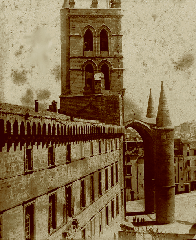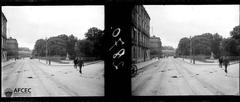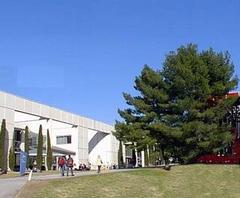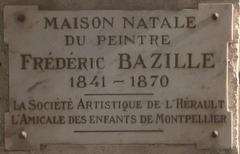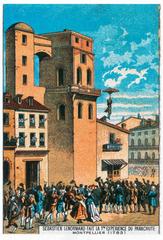
Comprehensive Guide to Visiting Montpellier, Hérault, France
Date: 14/08/2024
Captivating Introduction
Welcome to Montpellier, a city where the whispers of medieval history blend seamlessly with the vibrant pulse of modern life. Imagine strolling through narrow cobblestone streets, where every corner holds a secret and every building tells a story dating back to the 10th century. Montpellier, nestled in the Hérault department of the Occitanie region in southern France, beckons travelers with its rich tapestry of history, culture, and architectural marvels. From its founding in 985 AD by the Count of Toulouse, who granted the land to the Guilhem family, Montpellier has flourished as a significant medieval trading center (source).
As you wander through this enchanting city, you’ll discover the imposing Gothic majesty of the Saint-Pierre Cathedral, the lively buzz of the Place de la Comédie, and the Roman-inspired arches of the Saint-Clément Aqueduct. Picture yourself enjoying a café au lait at a bustling café, the aroma of fresh croissants wafting through the air, as street musicians serenade you with their vibrant tunes. Montpellier is not just a city; it’s an experience that engages all your senses and leaves you with memories to cherish.
Whether you’re a history enthusiast eager to explore the medieval roots of the University of Montpellier, one of the oldest universities in the world, or an art lover ready to lose yourself in the treasures of the Fabre Museum, Montpellier promises an adventure like no other. This guide will take you on a journey through time, revealing the heart and soul of this magnificent city. So, pack your bags, brush up on your French, and get ready to uncover the hidden gems of Montpellier.
Table of Contents
Historical Significance of Montpellier, Hérault, France
Early History and Founding
Montpellier, located in the Hérault department of the Occitanie region in southern France, has a rich history dating back to the 10th century. The city was first mentioned in historical records in 985 AD when the Count of Toulouse granted the land to the Guilhem family. This marked the beginning of Montpellier’s development as a significant medieval trading center. The city’s strategic location near the Mediterranean Sea facilitated its growth as a hub for commerce and culture.
Medieval Period
Montpellier flourished during the medieval period as a center of trade and education. The establishment of the University of Montpellier in 1220, one of the oldest universities in the world, played a crucial role in the city’s development. The university became renowned for its faculties of medicine and law, attracting scholars and students from across Europe. The Faculty of Medicine, established in the 12th century, is particularly notable for its contributions to medical knowledge and practice (source).
Architectural Heritage
Montpellier’s architectural heritage is a testament to its historical significance. The city boasts numerous historical buildings that reflect various architectural styles from different periods.
Saint-Pierre Cathedral
The Saint-Pierre Cathedral, built in the 14th century, is a prime example of Gothic architecture. Its imposing structure, complete with twin towers and a fortress-like appearance, was commissioned by Pope Urban V. The cathedral was converted from a monastery church to a cathedral in 1536 and played a significant role during the Wars of Religion in the 16th century (source). Don’t miss the secret garden behind the Saint-Pierre Cathedral—it’s a local favorite for a quiet escape.
Place de la Comédie
The Place de la Comédie, built in the 18th century, is one of Montpellier’s most famous squares. It features the iconic “Three Graces” statue by sculptor Étienne d’Antoine. The square is surrounded by historical buildings and cafes, making it a central point for both locals and tourists (source). Picture yourself enjoying the aroma of freshly baked pastries while listening to the sound of street musicians.
Saint-Clément Aqueduct
The Saint-Clément Aqueduct, constructed in the 18th century by hydraulic engineer Henri Pitot de Launay, was designed to supply water to Montpellier. The aqueduct’s most notable section features a double row of Roman-inspired arches, known as Arceaux, which are reminiscent of the Pont du Gard in the Occitanie region (source).
Renaissance and Baroque Influences
Montpellier’s historical buildings also showcase Renaissance and Baroque influences. The Peyrou Castle, built in the 17th century, is located at the highest point of the city and offers panoramic views. The castle was constructed in honor of King Louis XIV and is a fine example of Baroque architecture (source).
Jewish Heritage
Montpellier’s Jewish heritage is represented by the Mikvé, a Jewish ritual bath built in the 12th century. The Mikvé is one of the oldest surviving Jewish buildings in Europe and reflects the city’s diverse cultural history (source).
Modern Developments
In the 20th and 21st centuries, Montpellier has continued to evolve while preserving its historical heritage. The Antigone district, designed by Catalonian architect Ricardo Bofill in the 1970s, showcases stunning neoclassical buildings and a vibrant urban landscape. This modern architectural marvel contrasts with the city’s ancient structures, highlighting Montpellier’s ability to blend the old with the new (source).
Cultural Significance
Montpellier’s cultural significance extends beyond its architectural heritage. The city is home to several museums, including the Fabre Museum, which houses important works of French and European art. The museum, established in the 19th century, features works by renowned artists such as Delacroix, Courbet, Monet, and Picasso (source).
Festivals and Events
Montpellier hosts various cultural events and festivals that celebrate its rich history and vibrant arts scene. The annual Cinemed International Mediterranean Film Festival is a renowned event that showcases the diverse cinematic traditions of the Mediterranean region (source). Additionally, the Montpellier Danse Festival is a major cultural event that attracts contemporary dance enthusiasts from around the world (source).
Visitor Tips for Montpellier, Hérault, France
Practical Information
Montpellier is well-connected by public transportation, making it easy for visitors to navigate the city. The Montpellier tramway, one of the most extensive networks in France, covers the city and its outskirts with four lines. The tramway is an efficient and eco-friendly way to explore Montpellier (source). For those interested in wine, the region of Occitanie is known for its exceptional wines. Vineyards in close proximity to Montpellier offer wine tasting experiences, allowing visitors to explore the city’s rich wine history (source).
Conclusion
Montpellier’s historical significance is evident in its well-preserved architectural heritage, cultural institutions, and vibrant festivals. The city’s ability to blend its rich history with modern developments makes it a unique and captivating destination for tourists. Whether exploring medieval streets, admiring Gothic cathedrals, or enjoying contemporary art, visitors to Montpellier are sure to have a memorable experience. Ready to uncover Montpellier’s secrets? Download Audiala, your ultimate companion for an unforgettable journey through history and culture.
References
- Dabbling in Jet Lag, 2023, Unknown source url
- The Culture Trip, 2023, Unknown source url
- Tourist Platform, 2023, Unknown source url
- Facts.net, 2023, Unknown source url
- JJ Bucket List Travellers, 2023, Unknown source url
- Frenchly, 2023, Unknown source url








